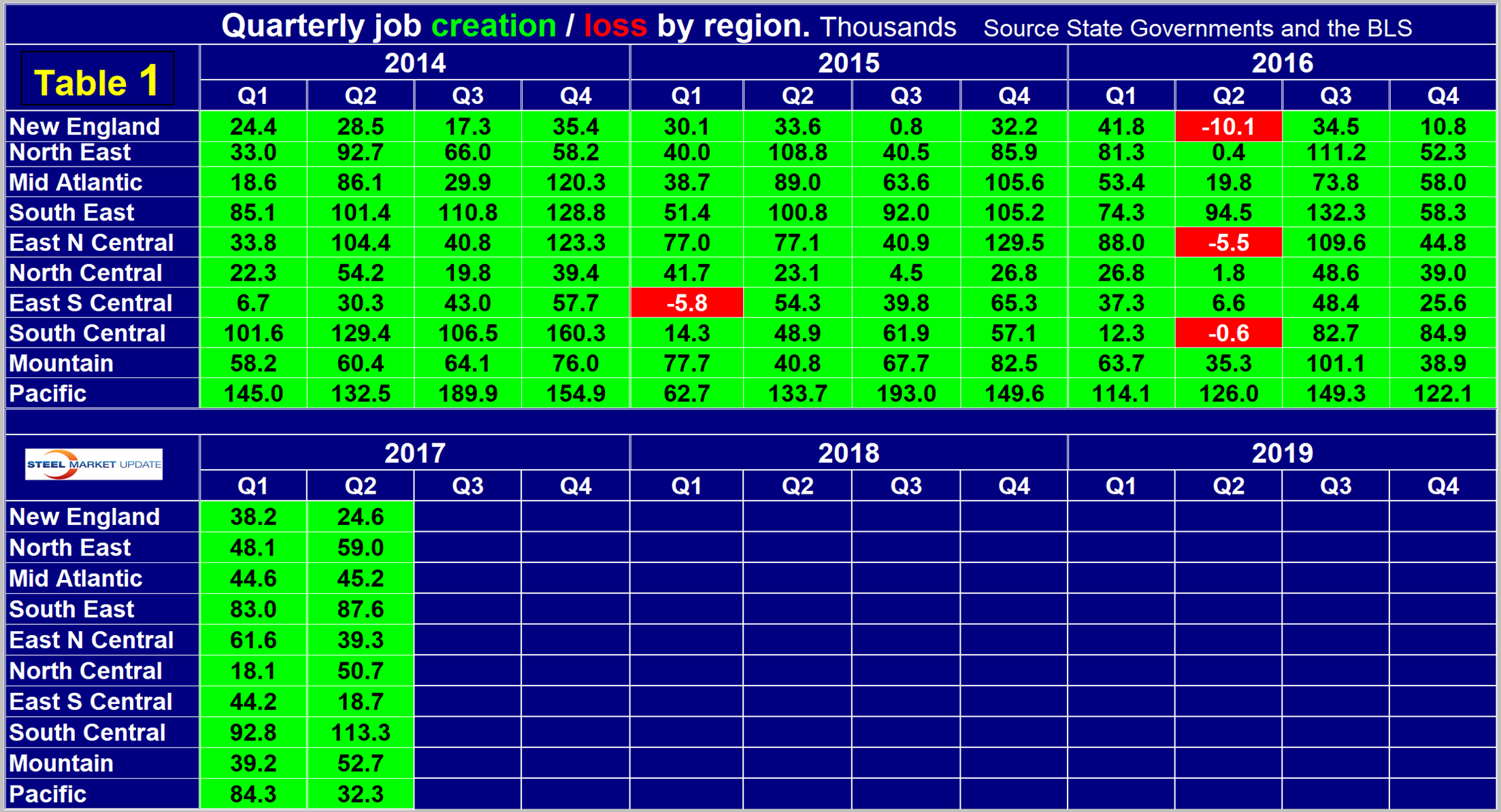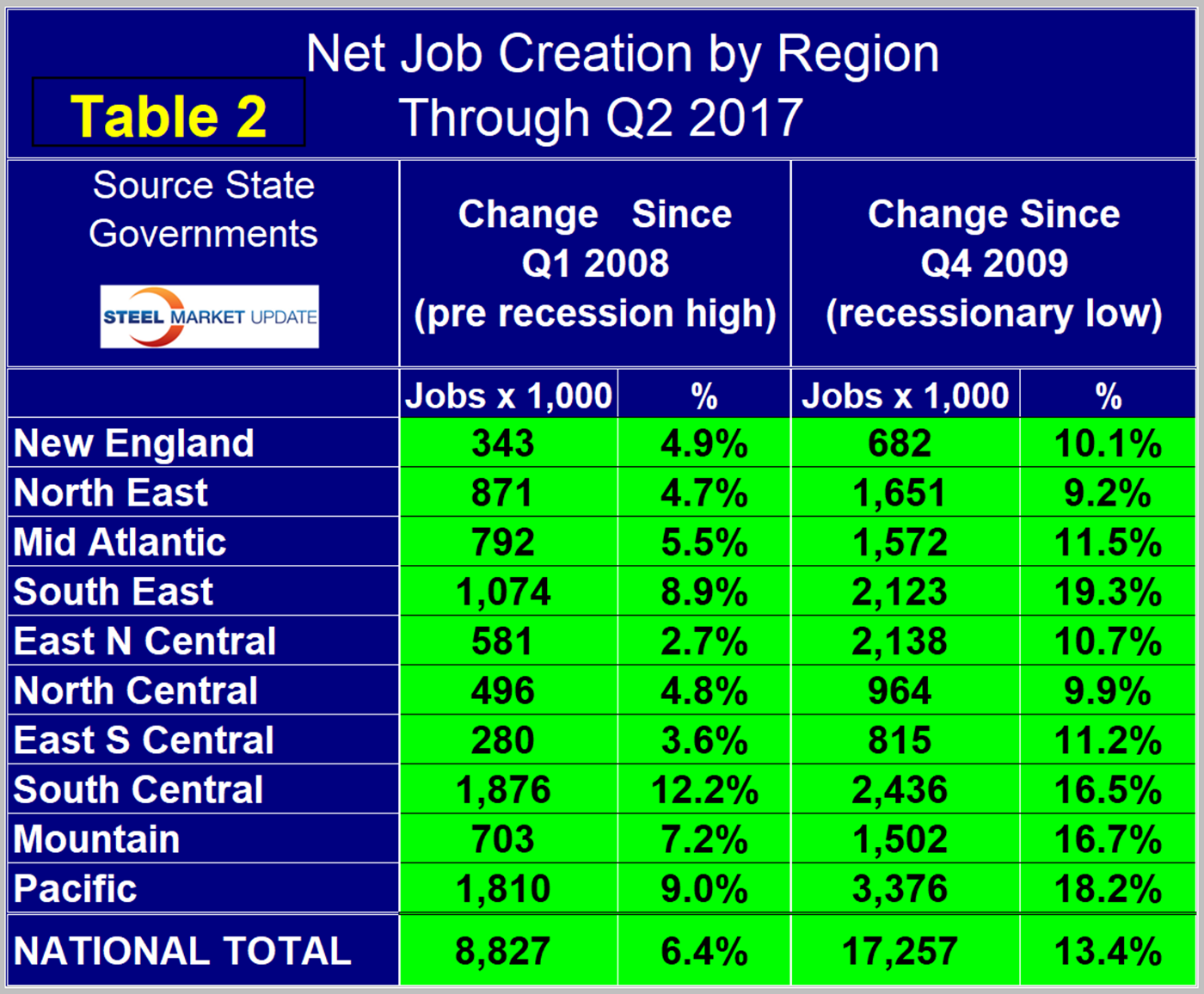Market Data

July 28, 2017
BLS Reports Positive Job Creation
Written by Peter Wright
The Bureau of Labor Statistics reports that job creation has been positive in all regions of the country since Q3 2016, in the second-quarter data it released on Friday.
Economy.com summarizes as follows: “The country’s labor market ended the second quarter on a strong note, with job growth in June that was stronger and more broad-based geographically than in May. Nonfarm employment in the lower 48 rose in 37 states. Texas, Georgia and Missouri reported the largest absolute gains with 40,200, 27,400 and 11,900 gains, respectively. Colorado and North Dakota had the lowest unemployment rates, and the rates in North Dakota and Tennessee set new lows dating back to 1976.”
The states compile their employment numbers independently of the Feds, and then both are reported by the Bureau of Labor Statistics. The results are close. In the last 18 quarters since Q1 2013, the Feds reported total job creation of 11,340,000 and the states reported 11,461,000, a difference of only 0.11 percent. Part of this small discrepancy is that the Feds capture offshore military personnel, but the states don’t. Figures 1 and 2 show the history of Federal and State totals since 1992. SMU has graphs in the same format for 10 geographic regions and can produce for individual states if a reader so requests.
Following are the 10 geographic regions described in this report:
New England (CT, ME, MA, NH, RI, VT)
North East (NY, PA, NJ)
Mid-Atlantic (DE, DC, MD, NC, SC, VA, WV)
North Central (IA, KS, MN, MO, NE, ND, SD)
East North Central (IL, IN, MI, OH, WI)
East South Central (AL, KY, MS, TN)
South Central (TX, OK, LA, AR)
Mountain (AZ, CO, ID, MT, NV, NM, UT, WY)
Pacific (CA, OR, WA)
South East (FL, GA)
Table 1 shows the history of quarterly job creation by region since Q1 2014 (click image to enlarge).
All regions had positive job creation in the final two quarters of 2016 and the first two of 2017. The effect of energy prices is evident in these regional employment reports. The South Central region went off a cliff in Q1 2015 after having the highest job creation of any region in the previous quarter. This region has steadily improved in the last four quarters and in Q2 2017 was well on its way to its historical performance. In the 10 quarters since Q4 2014, North Dakota has lost 29,800 jobs and Oklahoma has lost 12,800 jobs. But Texas, by virtue of its more broadly-based economy, has gained 556,800 jobs. In every quarter from and including Q2 2015 through Q4 2016, the Pacific region created the most jobs, but South Central took first place in Q1 and Q2 2017.
The regions have fared very differently since the pre-recession high of Q1 2008 and since the low point of Q4 2009. By the states’ calculations, there are now 8,827,000 more people employed than there were immediately before the recession, but of that number over half occurred in the South Central, Pacific and South East regions (Table 2).
The third quarter of 2015 was the first time that every region had more people employed than it did at the pre-recession peak. The Pacific has had the largest number of jobs created during the recovery with an increase of 3,376,000 positions, which amounts to 18.2 percent of total employment. The Pacific region also had the largest number of job losses during the recession. In second place in the recovery is the South Central region with 2,436,000 jobs created, which is 16.5 percent of total employment. Employment there is now 17,257,000 positions higher than it was at the low point of the recession and 8,827,000 positions higher than before the recession began. The East North Central region currently has the highest number of employed people with 22,037,700, but the Pacific with 21,898,500 is catching up fast (Table 3).
SMU Comment: We believe it’s important for those subscribers whose businesses are substantially regional to have as much data as possible to compare their own results with those of their locality. This report, along with regional GDP that we also report quarterly, is intended to help.












